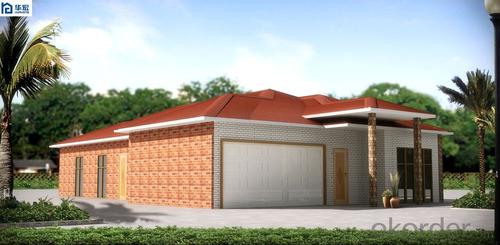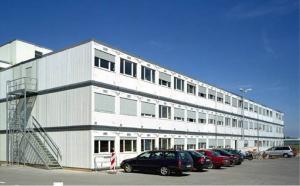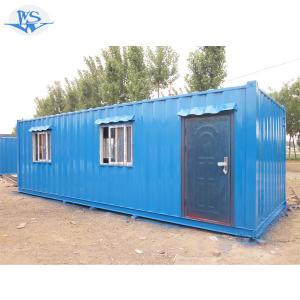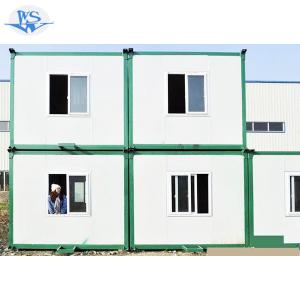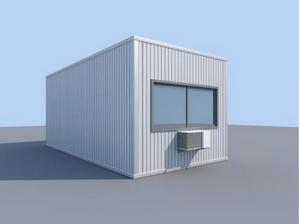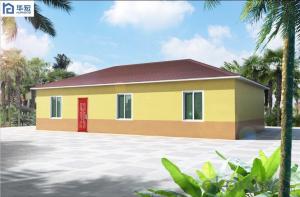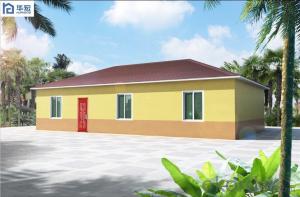Cheap cement house made in China
- Loading Port:
- China Main Port
- Payment Terms:
- TT OR LC
- Min Order Qty:
- -
- Supply Capability:
- -
OKorder Service Pledge
OKorder Financial Service
You Might Also Like
More questions:
1, What's your Payment term:
30% deposit by TT, 70% balance before loading container by TT; 100% LC at sight(total payment over 100,000USD);
2, How about Shipping:
We use 20 feet container and 40HQ container to ship the goods; Usually one 20 feet container can load about 50-60 square meters' house, 40HQ container can load about 120-140 square meters's house.
3, How to become your agent in our country:
First, you can make a report about your market, include the the rules and laws of prefab house, popular house models, target price, and potential sales quantity.
Second, you must place a trial order to act as the display.
Third, after finishing the sample house and getting the local people's feedback, we will give you the agent right in one area with limited time.
Fourth, Please note that we already have agent in Mumbai City India; Marshall Islands, Trinidad and Tobago.
4, Can you help me to purchase other things like furniture or appliance:
Because the customs law, our company can only export prefab house, so we just can purchase very little matched kitchen and bathroom facilities for you in consideration of customs clearance.
5, Can you send workers to help me build house.
Considering the labor cost, safety and visa issues, we suggest to send one or two engineers to guide and train your staffs. You must provide air tickets, hotel, and meal, and 100USD per day for engineer salary.
- Q: Are container houses suitable for home offices or workspaces?
- Yes, container houses are suitable for home offices or workspaces. They offer a cost-effective and versatile solution, providing a dedicated and customizable space for work. With proper insulation and design modifications, container houses can provide a comfortable and productive environment for remote work or running a business from home.
- Q: Are container houses suitable for building on sloped terrain?
- Yes, container houses are suitable for building on sloped terrain. Container houses are known for their versatility and adaptability, making them an ideal choice for various landscapes, including sloped terrains. One of the main advantages of container houses is their ability to be easily stacked or placed on different levels, allowing for a seamless integration with the natural contours of the land. This means that container houses can be built on sloped terrains without the need for extensive modifications or costly foundation work. In addition, container houses can be customized to fit the specific needs of the sloped terrain. For instance, the containers can be strategically positioned to take advantage of the natural views and sunlight, creating a unique and sustainable living space. Furthermore, container houses can be designed with various access points, such as stairs or ramps, to ensure easy and safe movement on the sloped terrain. Another important factor to consider is the durability of container houses. Made from strong steel structures, container houses are designed to withstand extreme weather conditions, including on sloped terrains where erosion and shifting of the land may occur. This ensures that the house remains stable and secure over time, providing a long-lasting solution for building on sloped terrain. Overall, container houses offer a practical and efficient solution for building on sloped terrain. With their versatility, adaptability, and durability, container houses can create unique and sustainable living spaces that embrace the natural features of the land.
- Q: Are container houses suitable for guest houses?
- Yes, container houses can be suitable for guest houses. Container houses are becoming increasingly popular due to their affordability, sustainability, and versatility. These structures are made from repurposed shipping containers, which makes them a cost-effective option for guest accommodations. Container houses can be customized to fit the needs of a guest house. They can be designed to include all necessary amenities such as bedrooms, bathrooms, kitchens, and living areas. Additionally, they can be modified to provide a comfortable and functional living space for guests. Container houses are also portable, which means they can be easily relocated if needed. This flexibility allows homeowners to move the guest house to different areas of their property or even take it with them if they move to a new location. Furthermore, container houses are eco-friendly. By utilizing repurposed shipping containers, these structures contribute to reducing waste and promoting sustainability. In an era where environmental consciousness is growing, many guests appreciate staying in accommodations that prioritize sustainability. In conclusion, container houses can certainly be suitable for guest houses. They offer affordability, versatility, and sustainability, making them an attractive option for homeowners looking to create comfortable and functional guest accommodations.
- Q: Are container houses suitable for guest or in-law accommodations?
- Yes, container houses can be suitable for guest or in-law accommodations. Container houses have become increasingly popular due to their affordability, durability, and versatility. They can be easily customized and modified to create comfortable and functional living spaces for guests or in-laws. One of the main advantages of container houses is their portability. They can be transported and installed in various locations, making them ideal for accommodating guests or in-laws on your property. Additionally, container houses can be easily expanded or connected to create larger living spaces if needed. Container houses can also provide a unique and modern aesthetic, which can be appealing for guests or in-laws looking for a distinctive living experience. With proper insulation, ventilation, and interior design, container houses can offer a comfortable and inviting environment for guests or in-laws to stay in. Furthermore, container houses are typically more cost-effective compared to traditional construction methods. They require less time and labor to build, resulting in lower overall costs. This can be advantageous when considering guest or in-law accommodations, as it allows for a more budget-friendly option. However, it is important to consider certain factors before choosing container houses for guest or in-law accommodations. These include local building regulations, zoning restrictions, and the need for proper amenities such as plumbing and electricity. Additionally, privacy and noise control should be taken into account when designing the layout of the container house. Overall, container houses can be a suitable and practical option for guest or in-law accommodations. With proper planning, customization, and attention to details, container houses can provide a comfortable and attractive living space for guests or in-laws while offering the benefits of affordability and versatility.
- Q: Can container houses be designed to be self-sufficient?
- Certainly, container houses have the potential to be self-sufficient. By carefully planning and integrating sustainable technologies, it becomes feasible to develop container homes that generate their own energy, collect and store rainwater, and effectively manage waste. In order to achieve self-sufficiency, container houses can incorporate renewable energy systems like solar panels or wind turbines. These systems have the ability to capture and convert sunlight or wind into electricity, which can then be used to power the appliances, lighting, and heating or cooling systems within the house. By utilizing energy-efficient appliances and LED lighting, container homes can optimize energy usage and reduce overall consumption. Moreover, container houses can also include rainwater harvesting systems. These systems are designed to collect rainwater from the roof, which can then be stored in tanks for various household purposes, such as flushing toilets, watering plants, or even filtering and purifying for drinking. This helps decrease reliance on municipal water supply and contributes to the conservation of water resources. When it comes to waste management, container houses can make use of composting toilets and greywater recycling systems. Composting toilets transform human waste into compost, which can be utilized as fertilizer for plants. Greywater recycling systems gather and treat water from sinks, showers, and laundry, making it suitable for non-potable uses like irrigation or toilet flushing. These systems minimize water waste and reduce the environmental impact of sewage disposal. Furthermore, container houses can be designed with proper insulation and ventilation to optimize temperature control, thereby lessening the need for excessive heating or cooling. Passive design strategies, such as strategic window placement, shading elements, and insulation, can assist in maintaining a comfortable indoor environment without relying heavily on energy-consuming HVAC systems. In summary, container houses have the capacity to be self-sufficient through the integration of sustainable technologies and the adoption of eco-friendly practices. While achieving complete self-sufficiency may require adjustments in lifestyle and consumption patterns, container homes offer a versatile and cost-effective platform for creating environmentally friendly living spaces.
- Q: Can container houses be customized to fit individual preferences?
- Certainly, container houses can be customized to suit individual preferences without a doubt. The flexibility offered by constructing a home using shipping containers is one of its key advantages in terms of design and customization. Due to the modular nature of containers, they can be easily modified to cater to specific preferences, needs, and requirements. There are various ways in which container houses can be customized. Firstly, the interior layout can be tailored to fit individual preferences. Containers can be combined or stacked to create multiple levels or open spaces. Rooms or open-concept living areas can be created by adding or removing walls. Moreover, the placement of windows, doors, and other openings can be customized to maximize natural light and scenic views. Secondly, container houses can be customized in terms of aesthetics. The desired look can be achieved by painting or cladding the exterior of the containers with different materials. This allows for a wide range of design options, ranging from modern and minimalist to rustic and industrial. Furthermore, a personalized and unique living space can be created by using various finishes, colors, and materials for the interior. In addition, container houses offer flexibility when it comes to incorporating additional features and amenities. For example, individuals can choose to include solar panels for sustainable energy, incorporate a green roof for improved insulation and environmental benefits, or install smart home technology for convenience and efficiency. In summary, container houses present numerous opportunities for customization. They can be adapted to suit individual preferences in terms of layout, design, and additional features. Whether someone desires a contemporary, traditional, or unconventional style, container houses allow for the creation of a personalized living space that aligns with individual tastes and requirements.
- Q: Are container houses suitable for coastal areas?
- Yes, container houses can be suitable for coastal areas. Container houses are built using shipping containers, which are made of sturdy steel and designed to withstand harsh weather conditions, including coastal areas with high winds, saltwater exposure, and potential flooding. The steel structure of container houses makes them highly resistant to corrosion caused by saltwater, which is a common issue in coastal regions. Additionally, the compact design of container houses allows for easy transportation and installation, making them suitable for coastal areas where building sites may be limited or inaccessible. Furthermore, container houses can be designed to be elevated on stilts or pilings, which helps protect them from potential coastal flooding and increases their resilience against rising sea levels. This feature is particularly advantageous for coastal areas prone to storms, hurricanes, or tsunamis. Another benefit of container houses in coastal areas is their sustainability. Recycling shipping containers for housing reduces waste and minimizes the environmental impact of construction. Additionally, container houses can be equipped with energy-efficient systems and materials, such as solar panels and insulation, reducing their carbon footprint and providing a sustainable living option in coastal areas. In conclusion, container houses are suitable for coastal areas due to their durability, resistance to saltwater corrosion, adaptability to various terrains, and sustainable construction practices. They offer a viable housing solution that can withstand the unique challenges presented by coastal environments.
- Q: Are container houses customizable in terms of layout and size?
- Container houses offer a great deal of flexibility when it comes to layout and size customization. Thanks to the modular design of shipping containers, they can be readily adjusted to match specific design preferences and necessities. By cutting and eliminating container walls, larger spaces can be created or multiple containers can be joined together to form a more sizable living area. Moreover, container houses can be stacked or arranged in different configurations to suit diverse layouts. This remarkable degree of customization empowers individuals to tailor their container homes to their own distinct requirements and personal tastes.
- Q: Are container houses suitable for agricultural purposes?
- Depending on the specific needs and requirements of the agricultural operation, container houses can indeed be a suitable option for agricultural purposes. They offer several advantages in terms of cost-effectiveness and efficiency. Container houses are a practical and efficient solution for creating temporary or permanent structures on agricultural land. They can be easily transported and assembled, making them an ideal choice for remote or temporary agricultural projects. Moreover, container houses can be customized and modified to meet various agricultural needs. They can be equipped with insulation, ventilation, and climate control systems to create a suitable environment for storing produce, growing plants, or housing livestock. Plumbing and electrical systems can also be installed to meet specific requirements of different agricultural operations. Furthermore, container houses are durable and weather-resistant, making them suitable for agricultural use in different climates. They are made from strong steel and can withstand heavy rain, wind, and extreme temperatures, ensuring the protection of agricultural products or livestock housed within them. Additionally, container houses offer a flexible and scalable solution for agricultural purposes. They can be easily expanded or modified by adding or removing containers, depending on the changing needs of the agricultural operation. This adaptability makes container houses suitable for both small-scale and large-scale agricultural projects. However, it is important to consider certain limitations when using container houses for agricultural purposes. They have limited space compared to traditional barns or sheds, so careful planning and organization are necessary to maximize the available area. Proper insulation and ventilation must also be installed to prevent condensation and maintain a suitable environment for agricultural activities. In conclusion, container houses provide a practical and cost-effective solution for agricultural purposes. They offer flexibility, durability, and adaptability, making them suitable for various agricultural needs. However, it is crucial to consider the specific requirements and limitations of the agricultural operation when utilizing container houses.
- Q: Are container houses suitable for art galleries?
- Container houses can indeed be suitable for art galleries. The use of shipping containers in architecture has become increasingly popular due to their versatility and affordability. When it comes to art galleries, container houses offer several advantages. Firstly, the modular nature of shipping containers allows for easy customization and expansion. Containers can be stacked, combined, or arranged in various configurations to create unique gallery layouts. This flexibility allows artists and curators to adapt the space to their specific needs and visions. Secondly, container houses are known for their durability. Made to withstand harsh marine environments, shipping containers are structurally robust and weather-resistant. This characteristic ensures the protection of valuable artworks from potential damage caused by external elements, such as moisture, pests, or extreme temperatures. Furthermore, container houses can provide an industrial and contemporary aesthetic, which can complement and enhance the artwork displayed within. The raw, minimalistic design of containers can create a unique backdrop for various art styles, from contemporary to avant-garde. Additionally, container houses are often more cost-effective compared to traditional building methods. The price per square foot for container construction is generally lower, allowing art galleries to allocate more resources towards the promotion and acquisition of artwork. However, there are some considerations to keep in mind when using container houses as art galleries. Insulation and climate control are crucial factors to ensure the preservation of delicate artworks. Proper insulation and HVAC systems should be installed to maintain stable temperature and humidity levels within the gallery space. Additionally, adequate lighting and security measures should be implemented to showcase the artwork effectively and protect it from theft or damage. In conclusion, container houses can be a suitable choice for art galleries, offering versatility, durability, affordability, and a unique aesthetic. However, it is essential to address insulation, climate control, lighting, and security to create an optimal environment for showcasing and preserving artworks.
Send your message to us
Cheap cement house made in China
- Loading Port:
- China Main Port
- Payment Terms:
- TT OR LC
- Min Order Qty:
- -
- Supply Capability:
- -
OKorder Service Pledge
OKorder Financial Service
Similar products
Hot products
Hot Searches

